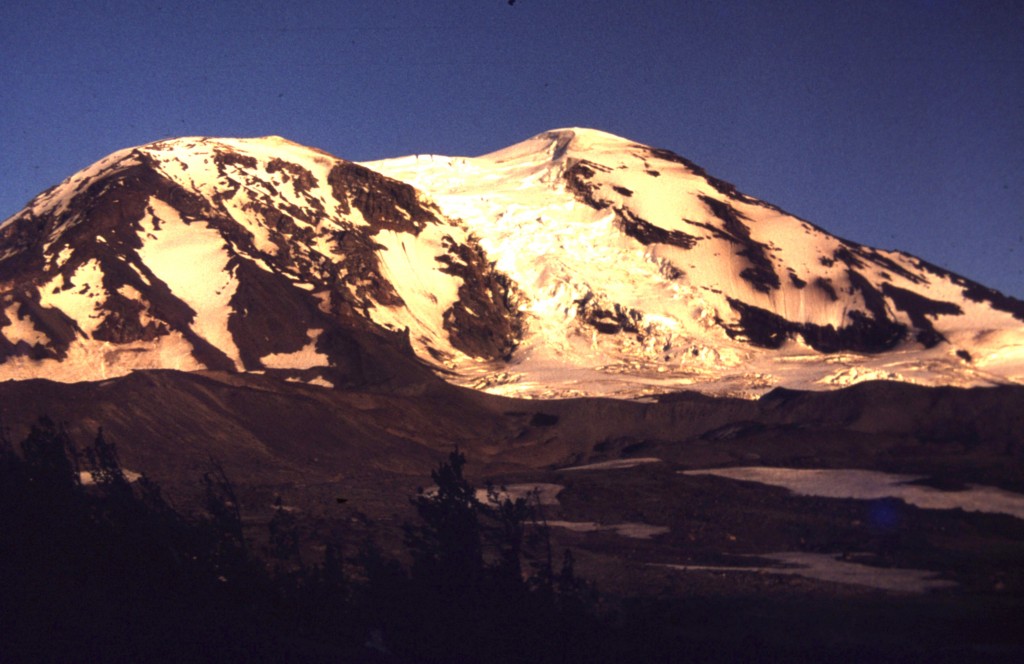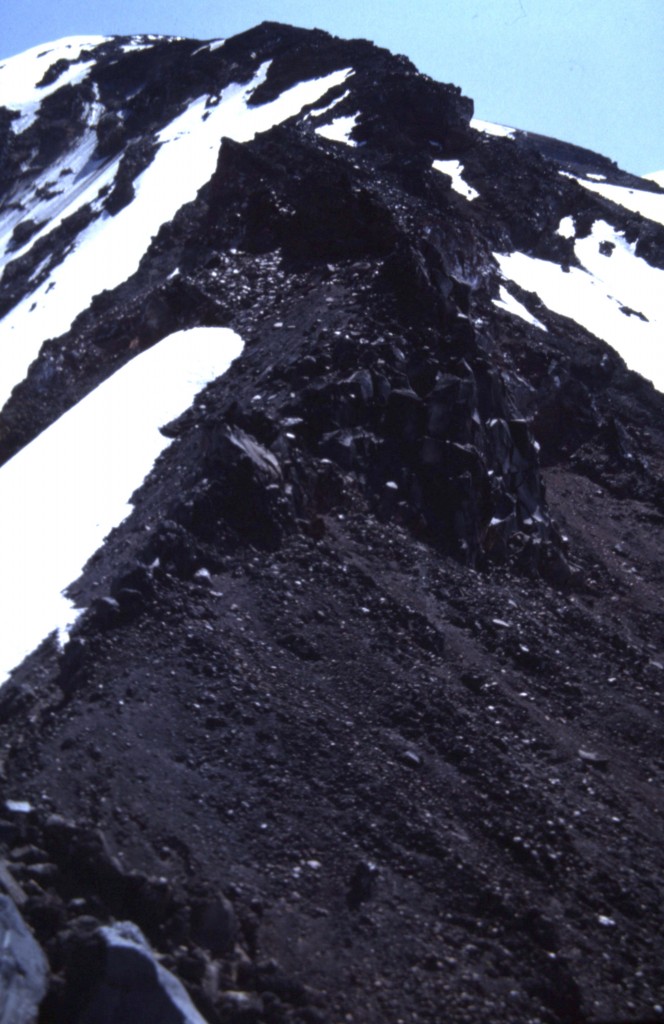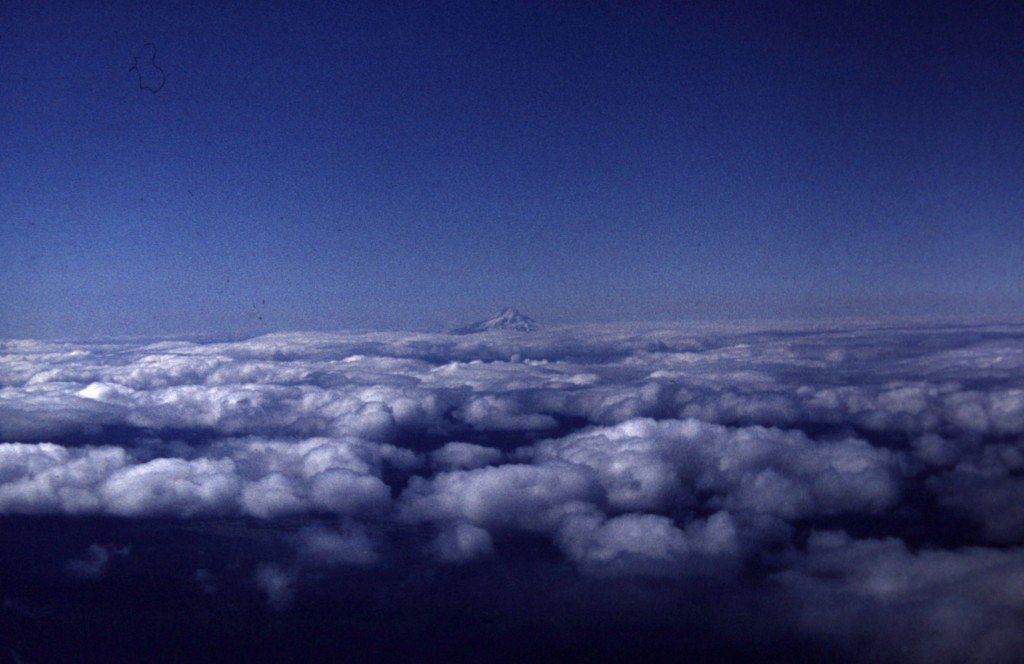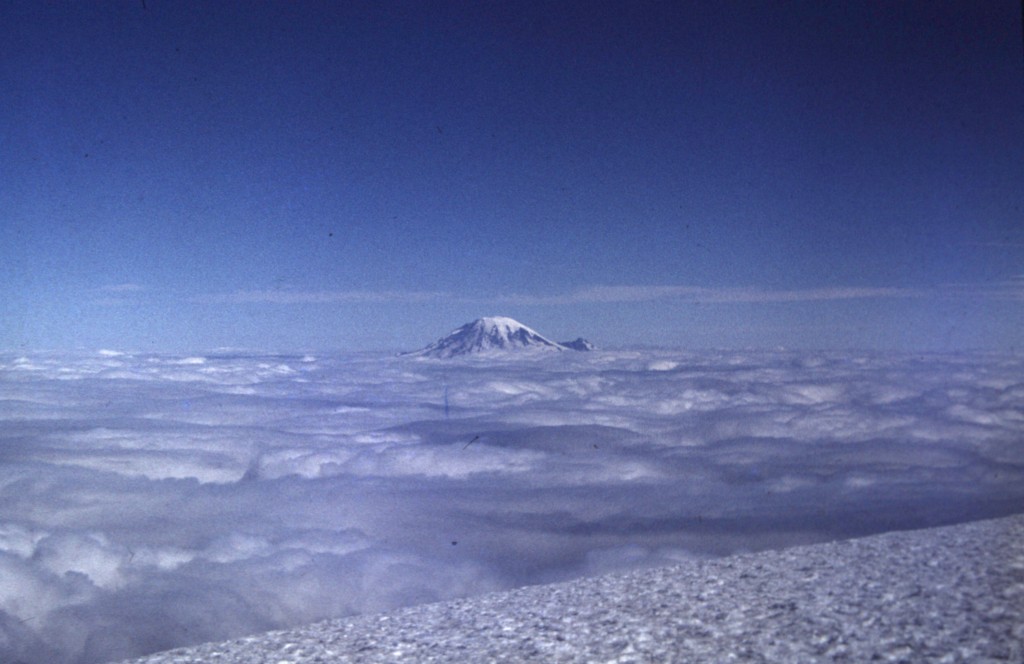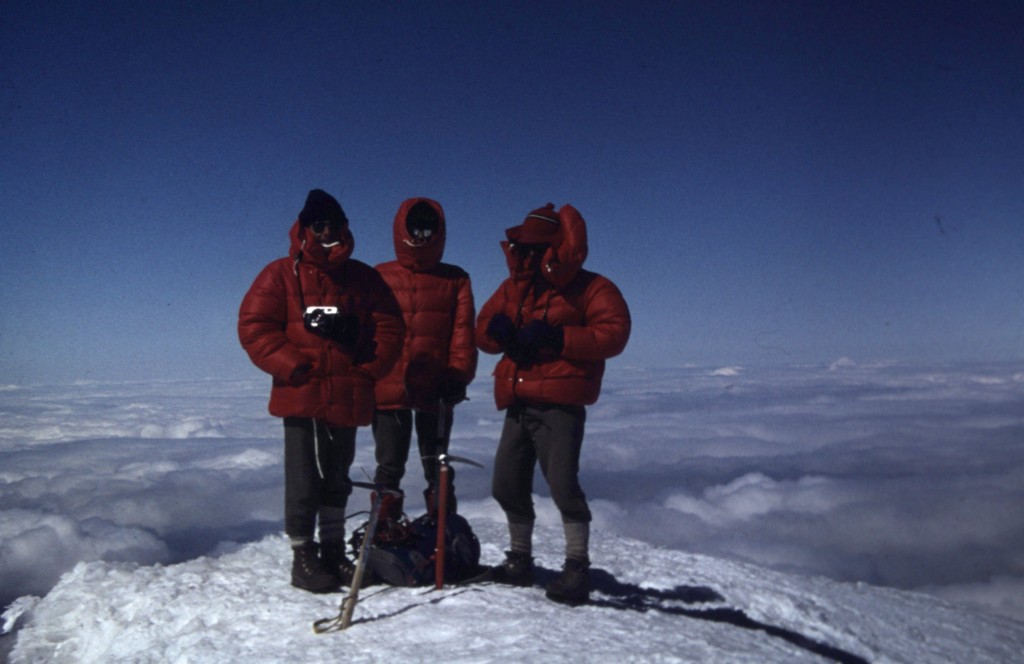Most of you who regularly read this site know that I’ve already published stories about Mt. Baker, Mt. Rainier and Mt. St. Helens. What those peaks have in common is that they are all big volcanic peaks in the Cascade Mountains of the northwestern part of the lower 48 states in the USA. I climbed all of them when I lived in British Columbia, Canada because that’s what we did – head down to Washington and climb the big peaks. In the summer of 1977, some of my friends were planning a climb of Mt. Adams and invited me along, and I was really excited to go. Some of them had made the long march in to the mountain before, and so were familiar with the area. I was the newbie, and it was pretty exciting stuff.
I was with a girl who didn’t much care for this kind of thing, but who had grudgingly agreed to come along. She made us slower than the rest of the large group who, out of politeness, patiently went along at our pace. It became obvious that she wasn’t going to make it all the way to the campsite in Killen Meadows that the group had chosen, so I decided to stop lower down – she and I would camp there overnight while the others moved higher. The next photo shows some of our route the next day – the North Cleaver goes up the rocky ridge on the far left, then up the snow and ice to the right of that, and to the summit seen just right of center.
We set up my McKinley tent and settled in. To this day, I can’t remember if I then went up to see the others and discuss our strategy that same afternoon, or if we talked about it before they left us lower down. Either way, I was pretty bummed out because I wasn’t up at their camp enjoying the company of my fellow climbers, but rather was lower down listening to all of the whining about how hard it had been so far. It was obvious she wasn’t going to be climbing the mountain, and would have to spend the whole time waiting at the tent for my return.
I awoke at an insanely early hour, got ready and headed up to greet the others. It was the middle of the night, and I wasn’t used to such early starts, so I was pretty bleary-eyed when I reached their camp. The route we’d chosen was the North Cleaver and it was the 3rd of July – pretty early in the season as far as many would be concerned. By the time we set out, it was a quarter of three in the AM, later than we’d hoped to leave. We had headlamps but back in 1977 they were pretty pathetic and cast a poor light. A full moon helped out a lot, though.
The climb up the ridge was on loose, rotten rock and we all had to be really careful of our footing. I remember how we spent a lot of our time fishing around on the ridge looking for the best route, that that was important and demanded a lot of attention. At some point I started to feel nauseous from the altitude, and one of the others clued me in to the fact that eating some antacids could help. That was the first time I’d ever tried that, and much to my amazement and delight, it worked. In short order, my queasiness went away and I felt almost human again.
The wind just kept getting stronger as we climbed, and became positively outrageous. That, combined with the early hour and the altitude, made for a very cold climb. I was wearing a huge REI Denali parka, and my upper body felt warm, but the wool knickers and knicker-socks weren’t cutting it, so my legs felt cold – so did my feet. We weren’t all that high, definitely less than 9,000 feet, when one of our party decided to call it quits – the cold was just too much for him – and that was the right move for him to make, considering we still had over 3,000 vertical feet left to climb. It was still early, maybe 4:30, when he started down. The rest of us struggled on through the insane winds, stopping to rope up and put on crampons when we left the rock slopes and started out on the snow.
It must have been 9:30 AM, at least, by the time we stepped on to the summit. The view was amazing – we were up in clear air, but below us the world was socked in with a blanket of clouds. We could see the tops of the other big volcanoes in the distance, but didn’t stick around to enjoy the scenery – it was too damn cold.
Our descent was really fast, and maybe four hours later we were back in camp. I continued on down to where my tent was still standing, amid a light dusting of snow. By the time we packed up, the others had arrived and we all started the walk back to the vehicles. It was slow and my feet hurt like hell, but it had been a good climb. Thanks to Ross Lillie for the use of his photos that he took on that day so long ago.
Now, here’s the rest of my Mt. Adams story. Thirteen years later, in 1990, I had occasion to return to the mountain with my friend, Susan. We had been climbing our way north during the summer, and so far had done Lassen Peak, Mt. McLoughlin, Mt. Thielsen and a few others (we would go on to finish out the summer on Rainier, North and Middle Sister, Shasta and Whitney). June 20 found us calling at the ranger station near Trout Lake, Washington. We told them we wanted to climb Mt. Adams via its south side, and could we drive the forest service roads to their end and start from there? They informed us that the winter’s snow still lay heavily on the mountain and that we were out of luck, there’s no way we could drive to the upper end of the road. Not only that, so far this year nobody had climbed the peak from the south side, and they strongly advised against even trying. Deep snow lay on the entire mountain and we wouldn’t see one bit of bare ground all the way up.
We thanked them for their information and left, more determined than ever to try to do the climb that very night. They hadn’t outrightly forbidden us from doing it, but had more or less said we’d be crazy to even try due to the depth of the snow – we didn’t have snowshoes. Forest Service map in hand, we excitedly drove up the road, hoping to get as high as possible. The ranger station was way down at 2,000 feet elevation, and it was our hope that we could drive all the way up to the end of the road at Cold Springs campground at 5,500 feet. It all went well for a while, but imagine our disappointment when we reached 5,000 feet and found the road covered in snow, snow that was still melting from the winter’s snow pack. Dang, it was a blow – without the snow, we could have driven to the end of the road, but now we were forced to start much lower. The snow lay deep on the road and we couldn’t drive one bit farther.
So now what? This was going to change everything, having so much extra distance to go. Was it still worth it? It was going to be a hellacious effort, but we’d be the first ones up this season if it worked, and that’d be pretty cool. We felt we were in pretty good shape from the climbing we’d done the previous week, so decided to go for it. Loading up our day packs, we set out at around 6:00 PM, making good use of the longest day of the year. Walking on the snow was a chore, as we kept sinking in. It was 2 1/2 miles along the snow-covered road to reach its end at the Cold Springs campground, and even that was an effort. From there, we could follow the markings on the trees that showed the location of the trail and in two more miles had reached Timberline Camp at around 6,250 feet elevation. This place was well-named, as the trees had so thinned out by then that we had really good views up the mountainside and felt we could keep going. That had been a major goal, to get more-or-less to treeline in daylight – that way, we wouldn’t have to deal with navigating through the forest in the dark. Above treeline, we felt we could manage that by headlamp.
The moon was no help as it was new, and had set with the sun, but it’s amazing how much you can see on a snow slope by starlight. We had headlamps of course, but didn’t really need them. The slope was gentle and free of obstacles, so all we had to do was put one foot in front of another and keep going in the right direction. It was a long, wonderful night. The later the hour and the higher our elevation, the harder the snow became as it froze. At some point we put on our crampons and just kept going. Nevertheless, it was tiring work. We felt we had all the time in the world, so we often stopped to rest, just sitting on the snow. Our route took us up on to a large snowfield, but truth be told, the entire mountain was one gigantic snowfield to us. At around 9,300 feet there was an area called the Lunch Counter (not sure why) that some parties used as a high campsite – I understand that it’s a jumbled rocky area, but the snow was so deep we couldn’t even see any rock.
We didn’t eat much, but sipped water from time to time. Dawn came early and it was a beautiful sight. One stroke of good luck was the lack of wind, the complete opposite of my 1977 climb. Hours passed. There was a false summit at around 11,700′, and from there we stayed on the left side of the ridge. By late morning we stood on the summit of Mt. Adams at 12,276′. I remember the sulfurous smell – it is a dormant volcano, after all – and the outrageous views. Conditions were so perfect up there in the sunshine, with no wind, that we spent quite a while enjoying our accomplishment. For once in my mountaineering life, I didn’t feel in any hurry to leave. Eventually we did, though. We took our sweet time going down – the sun had softened up the snow and we sank in quite a bit. Even during our descent, we stopped pretty often to rest and admire our surroundings. Late in the afternoon, we reached treeline and Timberline Camp. There were still 4 1/2 miles more to go until we reached our truck, parked right where we had left it where the snow ended and the pavement began.
The entire climb, from truck to summit to truck, had taken the outrageous time of 25 hours. We just took our time, never overdid it, rested often and had a good time. Susan thoroughly enjoyed every minute of it, as did I. Looking back on it, it may well be the longest time I ever took to climb a peak in one continuous push. After we changed out of our wet clothes and boots, we drove down the mountain to the ranger station – they were closed, but we left them a nice note telling them that the couple from the Arizona desert had just done the first ascent of the peak by its south side that season.
Please visit our Facebook page at: https://www.facebook.com/pages/Desert-Mountaineer/192730747542690

